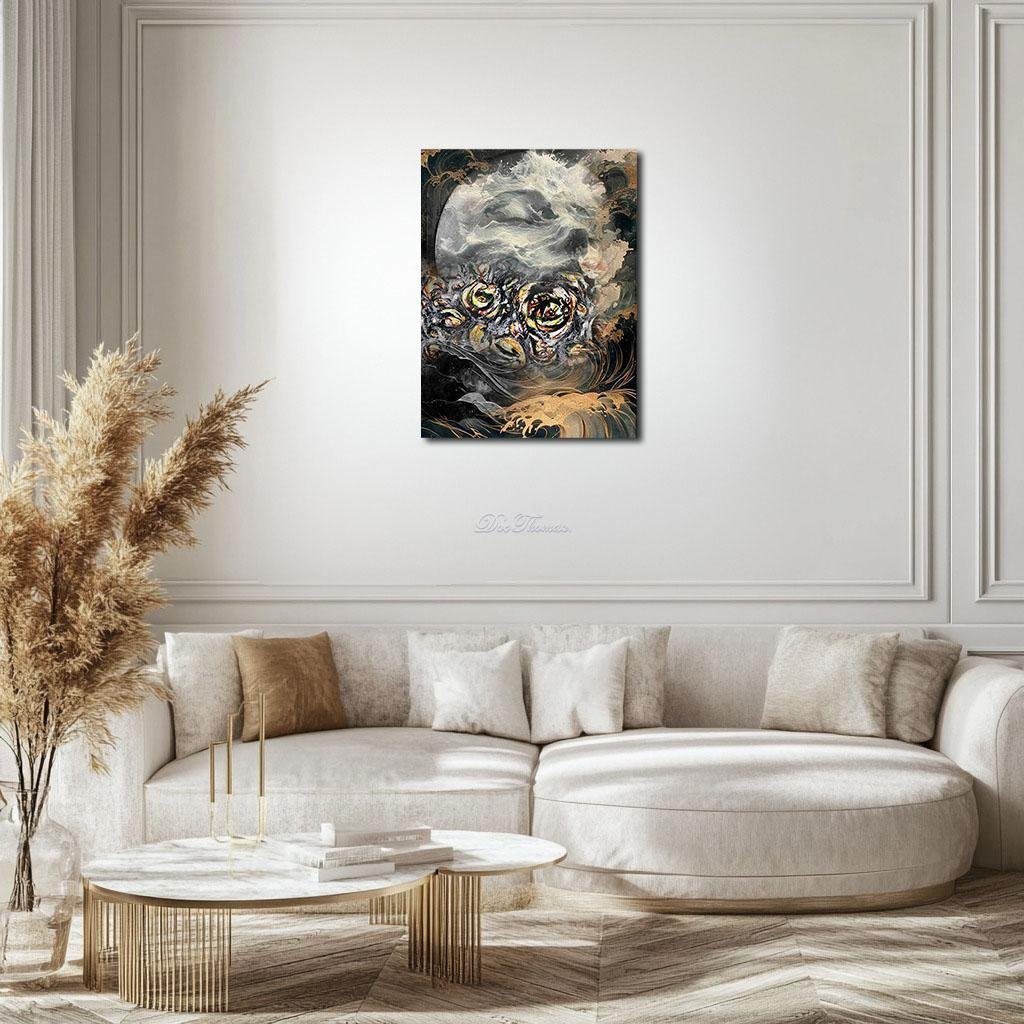Veins of Porcelain: The Weight Beneath the Tide
Veins of Porcelain: The Weight Beneath the Tide reframes Pollock’s Ocean Greyness as a mythic undercurrent of loss and beauty. His chaotic swirls are transformed into churning oceanic vortices, echoing memory, collapse, and cosmic silence. A pale moon-face watches through mist, while gold-crested waves rise like sacred fire around black foam and fragmented light. Pollock’s blacks anchor the storm; his yellows flicker like warnings; his whites cut like ghost tides. This is not the sea we look at—it is the sea we feel inside us. The one that pulls, even when we think we’re standing still.
Please see Below for Details…
Hotline Order:
Mon - Fri: 07AM - 06PM
404-872-4663
Veins of Porcelain: The Weight Beneath the Tide reimagines Jackson Pollock’s Ocean Greyness as a turbulent elegy of depth, loss, and the silent violence of nature’s rhythm. In this composition, Pollock’s original brushwork—once interpreted as storm or abstract fragmentation—is restructured into a sentient tide. The canvas is no longer surface—it is undertow. It is the memory of drowning etched in gold, the echo of a scream absorbed into salt.
At the core of the image, Pollock’s frenetic swirls, blistered with white, yellow, orange, and black, have been sculpted into tidal vortices—each a maw of memory spiraling inward. The textures become whirlpools of psychic unraveling, each rotation a heartbeat heard underwater. His marks, which once danced across canvas, now rise in sculptural tides, woven into foamy crownings that bridge the boundary between painting and tsunami.
Above this roiling ocean of marks, a moonlike presence looms—a pale orb nearly swallowed by storm. Its surface is made not of crater but of wave, a celestial body weathered into sea. The ghost of a human face hovers just behind it, barely visible through the storm—a face drawn in vapor, expressionless, not entirely mournful but watching. This face could be Poseidon or Pollock himself, or perhaps simply the drowning consciousness of the world—suspended between breath and flood.
The surrounding waters are rendered with painterly restraint yet mythic density: swirling blacks fade into charcoal greys, overlaid by crashing crests of pearl-white surf. Traces of swirling smoke-like foam and ghostly mist rise from the breakers, creating the illusion of spirits being torn into air. From the corners of the piece, a pattern of stylized gold waves—borrowed from ancient Japanese ink traditions—lifts like flames from the sea’s edge, suggesting that even devastation can burn with beauty.
Color in this reinterpretation is a shifting language of mourning and momentum. Pollock’s internal palette remains at the heart—dominant swathes of black, sickle-shaped whites, bruised reds, deep amber, and startling yellow strokes. But now these colors move like sediment in a surge. His blacks form anchors—unrelenting voids at the center of chaos. His whites are no longer neutral—they’re bone-white, storm-white, the color of things swallowed. Yellow here is not joy—it’s the warning hue of a breached sky, the eye of the storm.
The gold that flows through the edges is not from Pollock—it is from the reinterpretation, a gilded gesture of reverence and irony. Gold, the symbol of value and sanctity, now frames destruction. It questions what we treasure, what we preserve. The ocean may be grey, but the mind projects halos onto its cruelty.
As an artist, my thought when creating this piece was to engage with Pollock not as an abstract expressionist, but as a mapmaker of psychological oceans. Ocean Greyness always read to me as a cry from beneath—not of drowning alone, but of being submerged in the weight of what we cannot name. I did not wish to soften that cry, nor to contain it. Instead, I sought to build a storm that could sing it more clearly.
I imagined the painting as a sea of collective memory. The viewer stands at the edge not of water, but of everything they’ve tried to forget—grief, momentum, creation, and undoing. The skull-like shapes that form inside the white surf are no accident—they suggest what the sea holds, what it returns. But none of it is grotesque. Instead, it is hauntingly beautiful. Like the moment before a wave breaks. Like the second before breath returns.
Veins of Porcelain: The Weight Beneath the Tide is not a portrait of the ocean. It is the sensation of being remembered by it. It does not crash—it consumes. The painting moves in spirals, its gravity invisible but undeniable. In it, Pollock’s chaos becomes undertow, his expression becomes pressure. The tide never roars in this piece—but it pulls.
Add your review
Your email address will not be published. Required fields are marked *
Please login to write review!
Looks like there are no reviews yet.








